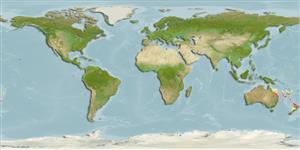Teleostei (teleosts) >
Tetraodontiformes (Puffers and filefishes) >
Tetraodontidae (Puffers) > Canthigasterinae
Etymology: Canthigaster: Greek, kanthos = the outer or inner corner of the eye, where the lids meet, 1646 + Greek, gaster = stomach (Ref. 45335).
More on author: Ogilby.
Environment: milieu / climate zone / depth range / distribution range
Ecology
Marine; demersal; depth range ? - 250 m (Ref. 33352). Temperate
Southwest Pacific: Australia (Lord Howe and Norfolk Islands) and New Zealand (including Kermadec Islands) (Ref. 8879).
Size / Weight / Age
Maturity: Lm ? range ? - ? cm
Max length : 23.0 cm TL male/unsexed; (Ref. 2272)
Life cycle and mating behavior
Maturity | Reproduction | Spawning | Eggs | Fecundity | Larvae
Paulin, C., A. Stewart, C. Roberts and P. McMillan, 1989. New Zealand fish: a complete guide. National Museum of New Zealand Miscellaneous Series No. 19. 279 p. (Ref. 5755)
IUCN Red List Status (Ref. 130435: Version 2024-2)
Threat to humans
Harmless
Human uses
Tools
Special reports
Download XML
Internet sources
Estimates based on models
Preferred temperature (Ref.
123201): 16.1 - 24.7, mean 22.2 °C (based on 26 cells).
Phylogenetic diversity index (Ref.
82804): PD
50 = 0.5000 [Uniqueness, from 0.5 = low to 2.0 = high].
Bayesian length-weight: a=0.03631 (0.01554 - 0.08482), b=2.88 (2.69 - 3.07), in cm total length, based on LWR estimates for this Genus-body shape (Ref.
93245).
Trophic level (Ref.
69278): 3.1 ±0.3 se; based on size and trophs of closest relatives
Resilience (Ref.
120179): High, minimum population doubling time less than 15 months (Preliminary K or Fecundity.).
Fishing Vulnerability (Ref.
59153): Low vulnerability (13 of 100).
Nutrients (Ref.
124155): Calcium = 55.4 [23.6, 134.3] mg/100g; Iron = 0.499 [0.205, 1.204] mg/100g; Protein = 17.6 [15.3, 19.8] %; Omega3 = 0.584 [0.262, 1.252] g/100g; Selenium = 17.1 [8.2, 38.7] μg/100g; VitaminA = 8.53 [2.04, 37.26] μg/100g; Zinc = 0.589 [0.405, 0.932] mg/100g (wet weight);
